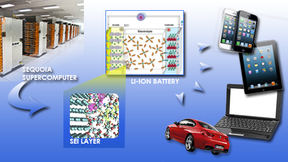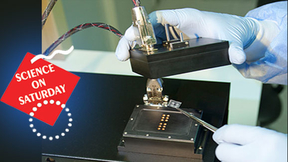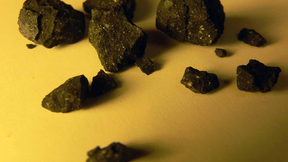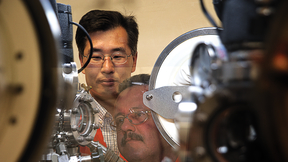Back
Physical and Life Sciences
It's only natural: Lawrence Livermore helps find link to arsenic-contaminated groundwater
Human activities are not the primary cause of arsenic found in groundwater in Bangladesh. Instead, a team of researchers from Lawrence Livermore National Laboratory, Barnard College, Columbia University, University of Dhaka, Desert Research Institute and University of Tennessee found that the arsenic in groundwater in the region is part of a natural process that predates…
NuSTAR helps solve riddle of black hole spin
An international team including Lawrence Livermore National Laboratory scientists has definitively measured the spin rate of a supermassive black hole for the first time. The findings, made by the two X-ray space observatories, NASA's Nuclear Spectroscopic Telescope Array (NuSTAR) and the European Space Agency's XMM-Newton, solve a long-standing debate about similar…
LLNL garners two top physics stories of 2012
Lawrence Livermore National Laboratory garnered two top physics stories from the American Physical Society's list of the top physics newsmakers of 2012. In May 2012, the two most recently discovered elements were given names after the physics labs that discovered them. Number 114 is flerovium (Fl) after the Flerov Laboratory of Nuclear Reactions in Dubna, Russia, and…
Retinal prosthesis LLNL helped develop is approved by the FDA
The U.S. Department of Energy announced Thursday that its support for a decade of revolutionary research has contributed to the creation of the first ever retinal prosthesis -- or bionic eye -- to be approved in the United States by the U.S. Food and Drug Administration for blind individuals with end-stage retinitis pigmentosa. LLNL engineers played a key role in the…
LLNL leads new initiative to improve lithium-ion batteries
A Lawrence Livermore team is working to improve lithium-ion battery performance, lifetime, and safety.Working with Lawrence Berkeley National Laboratory (LBNL), the scientists are developing a new methodology for performing first-principles quantum molecular dynamics (QMD) simulations at an unprecedented scale to understand key aspects of the chemistry and dynamics in…
Physicist Andris Dimits elected 2012 APS fellow
LIVERMORE, Calif. -- Andris Dimits, a physicist in the Fusion Energy Sciences Program at Lawrence Livermore National Laboratory (LLNL), has been selected as a 2012 American Physical Society (APS) fellow. Dimits was cited in the plasma physics category for "important insights and contributions to the theory and simulation of kinetic turbulent transport in magnetized plasmas…
Lab receives OPCW recertification
After a two-year process, the Laboratory has been recertified as a facility that can analyze samples collected during inspections under the Chemical Weapons Convention. In force since 1997, the Chemical Weapons Convention (CWC) has been ratified by 188 countries, including the United States, and is administered by the Organization for the Prohibition of Chemical Weapons …
Lab scientist receives NASA award for the Solar Dynamics Observatory mission
Lab Scientist Regina Soufli, a member of NASA's Solar Dynamics Observatory (SDO) Science Investigation Team recently received a Group Achievement Award from NASA.This certificate is awarded to a group of both government and non-government employees who together have made accomplishments that significantly contribute to NASA's mission. Launched in 2010, SDO is NASA's most…
New look at cell membrane reveals surprising organization
LIVERMORE, CALIF. - A new way of looking at a cell's surface reveals the distribution of small molecules in the cell membrane, changing the understanding of its organization. A novel imaging study by researchers from Lawrence Livermore National Laboratory, the University of Illinois and the National Institutes of Health revealed some unexpected relationships among…
LLNL's Saturday lectures explore cutting edge science
Lawrence Livermore National Laboratory's popular lecture series, "Science on Saturday," returns Jan. 26 and runs through Feb. 23. This year's talks cover a wide range of current topics including detecting pathogen DNA; the Lab's technologies used on NASA's NuSTAR Mission; the next generation medical diagnostic devices; and biofuels -- the new energy from ancient life.The…
Meteorite made up of rare early solar system material
It looked like a fireball in the sky. It created a sonic boom. It vaporized upon entering the atmosphere. It's all of the above: The Sutter's Mill Meteorite had the force of 4 kilotons of TNT upon descent and spilled samples of itself over the towns of Columa and Lotus in northern California when it hit Earth last spring. And now a consortium of scientists including…
DOE launches rare earth metals research hub
The Department of Energy has launched a research hub that focuses on solutions to the domestic shortages of rare earth metals and other materials critical for U.S. energy security. Housed at Ames Laboratory in Iowa, Lawrence Livermore has been involved in establishing this Energy Innovation Hub since its conception more than two years ago. In 2010, on behalf of DOE, LLNL…
Oxygen to the core
LIVERMORE, Calif. -- An international collaboration including researchers from Lawrence Livermore National Laboratory has discovered that the Earth's core formed under more oxidizing conditions than previously proposed. Through a series of laser-heated diamond anvil cell experiments at high pressure (350,000 to 700,000 atmospheres of pressure) and temperatures (5,120 to 7…
CAMS used to determine biological effects of silica nanoparticles
In a study published in a recent edition of Nano Letters , the Laboratory's Mike Malfatti, Heather Palko, Ed Kuhn and Ken Turteltaub report on accelerator mass spectrometry measurements used to investigate the relationship between administered dose, pharmacokinetics (PK), and long-term biodistribution of carbon 14-labeled silica nanopartocles in vivo .The increasing use of…
Lab research team solves condensed matter physics puzzle
Led by LLNL scientist Magnus Lipp and former LLNL scientist Joseph Bradley, researchers at the Lab, the University of Washington, Stanford and the Carnegie Institute have answered a longstanding, much debated question in condensed matter physics. The question has to do with the rare earth element cerium (Ce), which undergoes a surprising, large isostructural volume…
Laboratory partners with North Dakota State University in energy research
The Laboratory has partnered with North Dakota State University (NDSU) to collaborate on research and development projects involving computational-based modeling and simulation for energy and energy-related applications. NDSU President Dean Bresciani and LLNL Director Parney Albright finalized the agreement at a signing ceremony at NDSU on Dec. 14. Collaboration between…
Plutonium at 150 years
The article below presents a summary of ongoing work at Lawrence Livermore National Laboratory. The work is to assess how radioactive decay in plutonium affects its material properties as they relate to the performance of nuclear weapons. This work is a continuation of the joint plutonium aging study done by Los Alamos and Lawrence Livermore National laboratories. That…
X-ray laser takes aim at cosmic mystery
An international collaboration including researchers from Lawrence Livermore National Laboratory has refined a key process in understanding extreme plasmas such as those found in the sun, stars, at the rims of black holes and galaxy clusters. In short, the team identified a new solution to an astrophysical phenomenon through a series of laser experiments. In the new…
Science Express article describes new clues to planetary evolution
A new understanding of planetary evolution could emerge from studies of the behavior of magnesium oxide under high pressures and temperatures, such as those found in the interior of Earth and Earth-like planets. In an article recently published by Science Express , a team of UC Berkeley and LLNL researchers, led by former LLNL researcher Stewart McWilliams, now of the…
LLNL to work with Interior Department on underground coal gasification
LLNL's Underground Coal Gasification (UCG) Program has received a two-year research grant to study water-quality hazard mitigation strategies from the Office of Surface Mining Reclamation and Enforcement (OSMRE). OSMRE is a Department of the Interior bureau charged with ensuring the public and the environment are protected during and after coal mining operations. In recent…

























